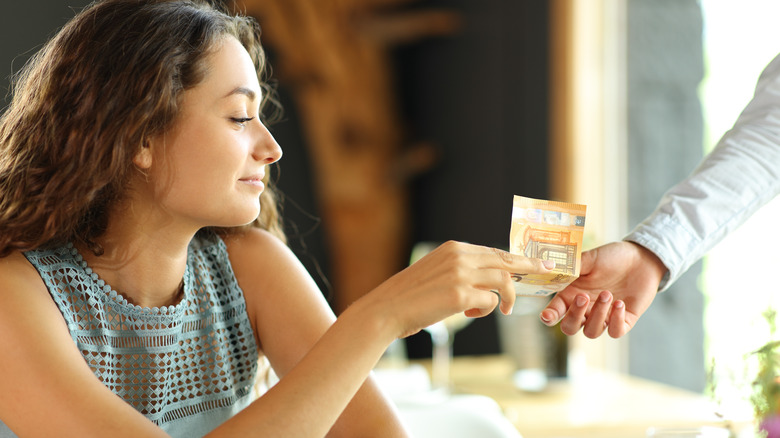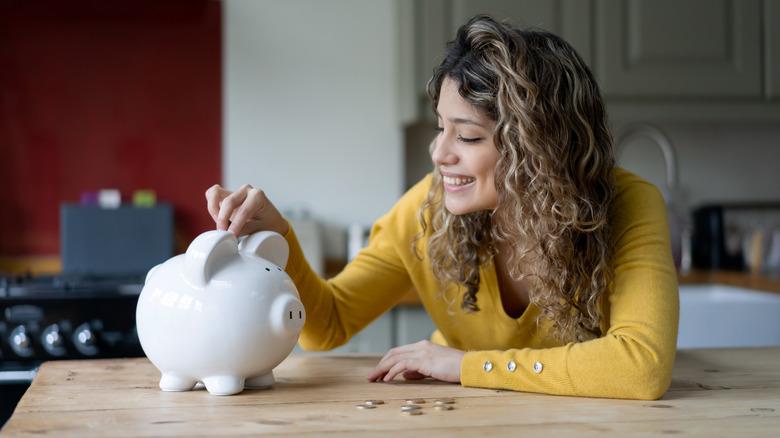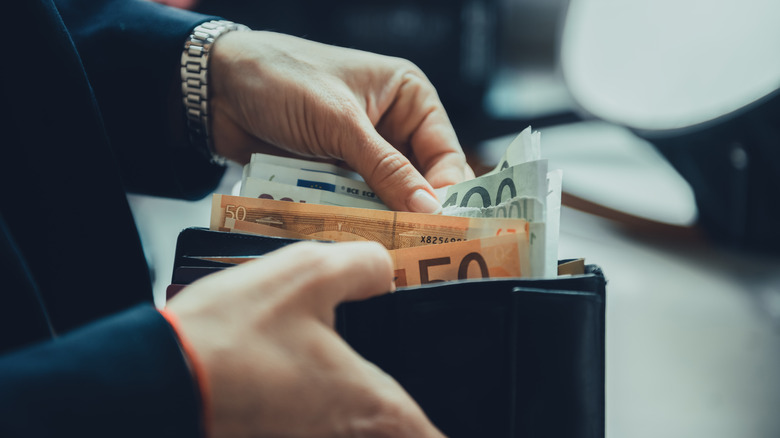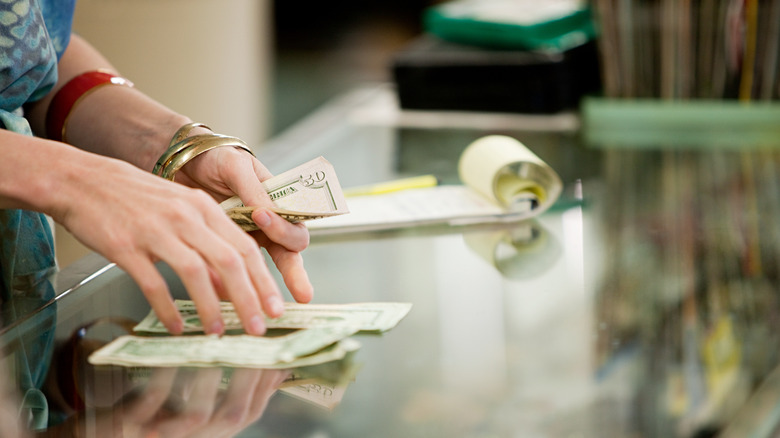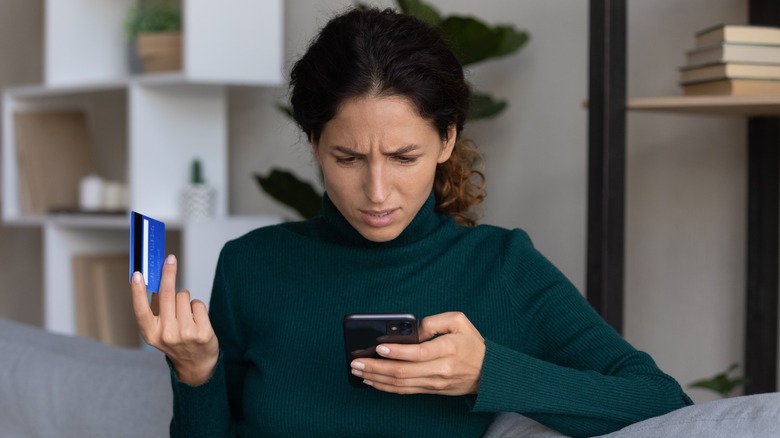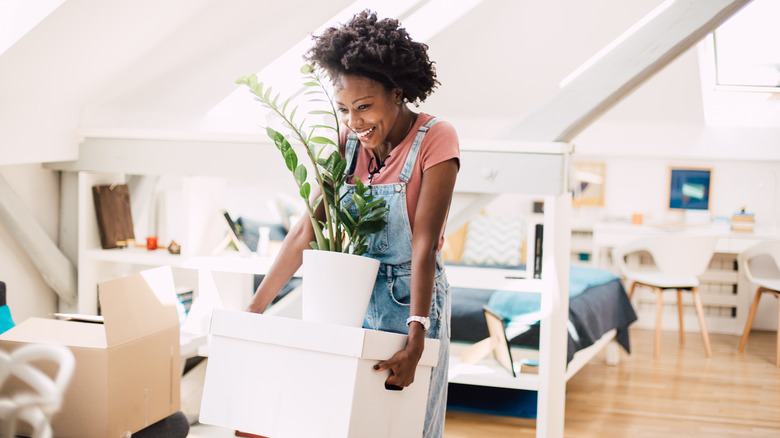Could Paying With Cash Help Curb Your Spending? We're Diving Into The Pros And Cons
Finances can be complicated. It's more than just the math involved with a budget, finding tax receipts, or trying to keep from spending money on every trending product on social media. There is also an emotional component to finances, whether we're trying and failing to resist the dopamine hit that comes from an online purchase or resisting impulse buys in the checkout line at Sephora. With the cost of food rising and the economy in rough shape, everyone is looking for tips to save money beyond freezing our credit cards in blocks of ice like the old sitcoms told us to do. That wouldn't help, with most of our cards stored online anyway. One method a lot of people are talking about is the cash-only lifestyle.
According to a story in The Cut, this concept is called "cash stuffing" or the "envelope method," and it's gaining popularity on TikTok. The idea has been around for a while (and, as the site points out, was popularized by radio host Dave Ramsey about a decade ago). The idea involves using only cash and apportioning it into envelopes for what you need. If you spend all the money, that's it. So, does this work? Let's explore the pros and cons of cash stuffing and how it can (and can't) work for you.
What is the theory behind this?
According to the article in The Cut, the theory is that you have envelopes set out for spending categories like food, hobbies, date night, etc. — you divide your cash into those envelopes, and when each of them runs out, that's it. That's all you have for the week, so in theory, you'll quickly learn to budget for the amount you need or cut your spending so you don't keep running out. The idea is that credit cards and online payments make it too easy to spend money. You already know this, we're sure. Decades ago, when we would think of something we wanted, we'd have to get up, drive to the store to make the purchase, resist all other items, then drive home. Now we just think of buying, say, that new skincare item in a list on a website with that one review that says it's amazing, and we open a site on our phones that already have our credit cards saved in them, and boom, it shows up at our doors.
We're conditioned to look at cash as a thing to hold onto, whereas credit cards stored on a website don't have the same reality in our lizard brains. In theory, using cash only should keep us from expensive whims. It can work, but it takes more than just cutting your cards in half. There are also a lot of drawbacks.
How to do it (because it's more than just carrying bills)
If you're going to try cash stuffing, you're going to have to take a few steps. First, you'll have to hit the ATM, which is far rarer than it used to be. This means that each time you're paid, a trip to the bank has to happen. It also means that you cannot forget your wallet and just take your phone with you on your morning run and pay for coffee with a click. It also means that you will have to remove your saved credit cards from websites. It will keep you off of Amazon, which isn't bad but also means less convenience. Another thing that has to happen weekly or biweekly is a budget. You'll need to sit down and calculate what you spend on things like that Starbucks trip or groceries so you can portion out your cash correctly.
Bills come first (including rent or mortgage payments), groceries, necessities, and fun time items. Unless you know your spending habits well (meaning you probably don't need this method anyway), it will be a complicated start to envelope stuffing. Plus, you probably have to go out and buy envelopes because, unlike yesteryear, you don't have them sitting around in your house for bill-playing.
How it can save you money
Not giving ourselves access to the quick dopamine hit from a seconds-long transaction online is going to take some time to get used to, but it can really help. In fact, it helps in the same way that detoxing from the dopamine hit of scrolling through social media does. Dopamine is, as Cleveland Health Clinic points out, "the hormone neurotransmitter in your brain that makes you feel good." You can get the hit from window shopping or even online shopping without a purchase, but for some of us, that's just going to lead to buying what we're craving at the moment.
Detoxing from this will take a bit, but living within a cash-only budget will do a few things for you. You'll have to take a look at what you spend on non-essentials, and that might give you a shock. This alone can help curb impulse buys. The idea of the cash in that envelope being all you have to spend can be liberating because you'll have to prioritize what you need over what you want. It's a pretty simple idea, and it can absolutely work ... if the drawbacks don't discourage you.
It's worth keeping in mind, as The Cut says, that you can do this without going completely cashless. You can do it for a shorter period of time (or while saving for something big) to get an idea of your spending habits, or just use this method for non-necessities. Or, if you have to use a card for something like Uber or Venmo, make a commitment to paying it off the second you get home.
The drawbacks (and there are a lot of them)
The drawbacks are pretty rough. First of all, many businesses are going cashless these days. One neighborhood restaurant in Los Angeles recently stopped taking cash as payment because of seven burglaries in seven months. Others don't want the hassle and danger of taking large amounts of cash to banks to deposit at the end of the day. Cashless payment became more prevalent during the pandemic when no one wanted to touch money that had been through many hands (paper money is full of germs) or even go into a store at all. If you don't carry credit cards, turned off phone payments, and only have a few singles, this could be a problem.
Add to that the fact that carrying cash isn't the safest thing to do. One method to fool pickpockets is to have a fake wallet with pieces of newspaper in it while your real wallet is under your clothing. While that's helpful when traveling, it's not really practical for every day. In fact, traveling usually requires credit cards if you don't want a crappy exchange rate in other countries or if you want to track your purchases with a paper trail. In addition, many things can only be purchased online, leaving you no option other than using a card.
Now this last drawback might sound silly, but if you remember the days of heavy purses because of loose change, you'll know how annoying that can be. A big jar near your front door is an old-fashioned but good idea if you want to save your pennies.
How do you build your credit if you're only using cash?
The cash stuffing saving method can help you if you're willing to put in the time. That said, some financial things require you to have a credit score, which requires credit cards. If you want things like a car loan, mortgage, or even an apartment, that score is going to be checked. You build up credit by using credit cards and paying them off promptly. No one is tracking your cash purchases, and even though it might make you more financially responsible, it's not something that a bank cares about when looking at lending you money.
One way around this is to pay for large things like rent or mortgage with credit, then immediately pay them off. That means if you pay rent on a card, you pay that card as soon as the payment posts, so you don't accrue interest. That also allows you to get whatever benefits your card offers, like points or airline miles.
Is "cash stuffing" perfect? Not in 2023, where we've gotten used to the fact that we can't buy, say, an airline ticket with cash. That said, if you're willing to give it a partial shot for hobbies and incidentals, it might just help you figure out where your paycheck is going and save some money.
